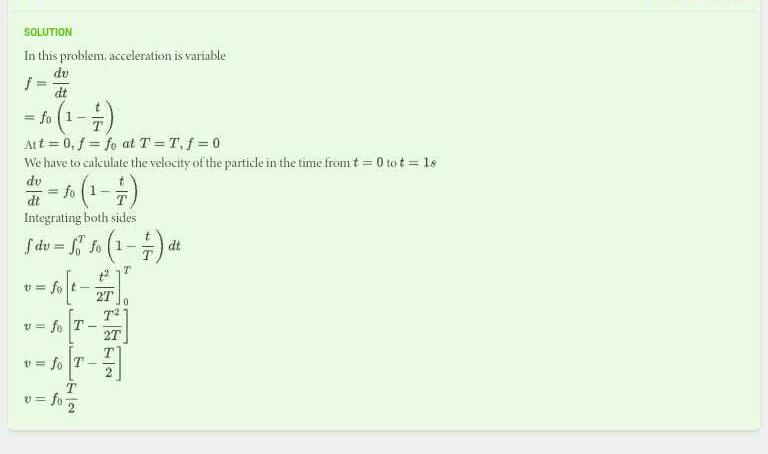JEE Exam > JEE Questions > A particle moving along x- axis has accelerat...
Start Learning for Free
A particle moving along x- axis has acceleration f at time t given by f = fo[1+t / T] where fo and t are constant. the particle at t = 0 has zero velocity .in time interval b/w t = 0 and instant when f=0 the particle velocity vx is?
Most Upvoted Answer
A particle moving along x- axis has acceleration f at time t given by ...

Community Answer
A particle moving along x- axis has acceleration f at time t given by ...
Acceleration and Velocity of a Particle Moving on x-axis
Given Information:
- Particle moves along x-axis
- Acceleration at time t is given by f = fo[1 t / T], where fo and t are constants
- Particle has zero velocity at t=0
Finding Velocity:
To find the velocity of the particle at the instant when f=0, we need to integrate the acceleration function with respect to time to get the velocity function.
Integration of Acceleration:
Taking the integral of the above acceleration function with respect to time, we get:
Simplifying the above equation, we get:
When f=0:
To find the velocity of the particle when f=0, we need to determine the value of t when f=0.
Solving the above equation, we get:
Therefore, the time interval between t=0 and t=-T is:
Substituting the value of t in the velocity function, we get:
Simplifying the above equation, we get:
Therefore, the velocity of the particle at the instant when f=0 is -fo/2.
Conclusion:
The velocity of the particle at the instant when f=0 is -fo/2.

|
Explore Courses for JEE exam
|

|
Similar JEE Doubts
Question Description
A particle moving along x- axis has acceleration f at time t given by f = fo[1+t / T] where fo and t are constant. the particle at t = 0 has zero velocity .in time interval b/w t = 0 and instant when f=0 the particle velocity vx is? for JEE 2025 is part of JEE preparation. The Question and answers have been prepared according to the JEE exam syllabus. Information about A particle moving along x- axis has acceleration f at time t given by f = fo[1+t / T] where fo and t are constant. the particle at t = 0 has zero velocity .in time interval b/w t = 0 and instant when f=0 the particle velocity vx is? covers all topics & solutions for JEE 2025 Exam. Find important definitions, questions, meanings, examples, exercises and tests below for A particle moving along x- axis has acceleration f at time t given by f = fo[1+t / T] where fo and t are constant. the particle at t = 0 has zero velocity .in time interval b/w t = 0 and instant when f=0 the particle velocity vx is?.
A particle moving along x- axis has acceleration f at time t given by f = fo[1+t / T] where fo and t are constant. the particle at t = 0 has zero velocity .in time interval b/w t = 0 and instant when f=0 the particle velocity vx is? for JEE 2025 is part of JEE preparation. The Question and answers have been prepared according to the JEE exam syllabus. Information about A particle moving along x- axis has acceleration f at time t given by f = fo[1+t / T] where fo and t are constant. the particle at t = 0 has zero velocity .in time interval b/w t = 0 and instant when f=0 the particle velocity vx is? covers all topics & solutions for JEE 2025 Exam. Find important definitions, questions, meanings, examples, exercises and tests below for A particle moving along x- axis has acceleration f at time t given by f = fo[1+t / T] where fo and t are constant. the particle at t = 0 has zero velocity .in time interval b/w t = 0 and instant when f=0 the particle velocity vx is?.
Solutions for A particle moving along x- axis has acceleration f at time t given by f = fo[1+t / T] where fo and t are constant. the particle at t = 0 has zero velocity .in time interval b/w t = 0 and instant when f=0 the particle velocity vx is? in English & in Hindi are available as part of our courses for JEE.
Download more important topics, notes, lectures and mock test series for JEE Exam by signing up for free.
Here you can find the meaning of A particle moving along x- axis has acceleration f at time t given by f = fo[1+t / T] where fo and t are constant. the particle at t = 0 has zero velocity .in time interval b/w t = 0 and instant when f=0 the particle velocity vx is? defined & explained in the simplest way possible. Besides giving the explanation of
A particle moving along x- axis has acceleration f at time t given by f = fo[1+t / T] where fo and t are constant. the particle at t = 0 has zero velocity .in time interval b/w t = 0 and instant when f=0 the particle velocity vx is?, a detailed solution for A particle moving along x- axis has acceleration f at time t given by f = fo[1+t / T] where fo and t are constant. the particle at t = 0 has zero velocity .in time interval b/w t = 0 and instant when f=0 the particle velocity vx is? has been provided alongside types of A particle moving along x- axis has acceleration f at time t given by f = fo[1+t / T] where fo and t are constant. the particle at t = 0 has zero velocity .in time interval b/w t = 0 and instant when f=0 the particle velocity vx is? theory, EduRev gives you an
ample number of questions to practice A particle moving along x- axis has acceleration f at time t given by f = fo[1+t / T] where fo and t are constant. the particle at t = 0 has zero velocity .in time interval b/w t = 0 and instant when f=0 the particle velocity vx is? tests, examples and also practice JEE tests.

|
Explore Courses for JEE exam
|

|
Signup to solve all Doubts
Signup to see your scores go up within 7 days! Learn & Practice with 1000+ FREE Notes, Videos & Tests.


























